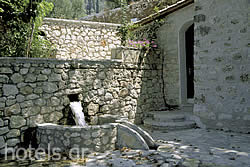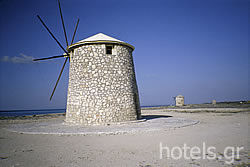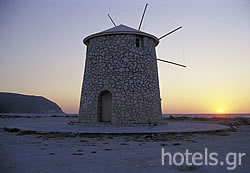 Architecture and Traditional Settlements
Architecture and Traditional Settlements
The islands capital is characterized by a medieval age city planning. It was developed after a specific plan expressing the feudalistic way of ruling during the years of Venetian captivity, where the basic city planning structure was formed.
The main square along with the temple of Saint Spyridon and the main shopping street, are the centre of the settlement, surrounded by a road shaped like a ring. A second ring, parallel to the first one, is formed on the north side of the settlement and passing in front of the churches, Panagia Ton Xenon and Agion Anargyron ends on the main shopping street. All secondary roads are arranged as radiuses to the cycle formed by the two main streets beginning from the center and resemble a fish bone. All roads of different direction end in squares whose position is determined by the existence of a church.
After the 1948 earthquake on the south side of the old settlement a new part of the island's capital was formed, called Neapoli. So in time the island's capital doubled in size and is still growing since the city plan of the Lefkada's Municipality has expanded even more.

In the Lefkada province there are two settlements officially characterized as traditional and are protected by law. These are, Syvota on the southeast and Aghios Nikitas on the west side of the island.
There are of course many villages and settlements, in the mountains and the small isles of the province, that have preserved the traditional elements in form and structure of the buildings, which are built from simple materials and are in harmony with the natural environment. These villages, with the simplicity and plainness of there buildings, reflect the measure of respect the Lefakadites always showed to nature and the natural environment and are a living picture of a traditional way of life. Elements of this tradition one may find in areas such as Katouna, Karya, Vafkeri, Niohori, Alatro, Katochori, Poros, Draganos, Kalamitsi, Exanthia, Drimonas, The municipality of Sfakiotes, Meganissi, Kalamos and Roupakias.
An authentic settlement with buildings of the traditional Lefkadite architecture is the village of Drimonas, build on a peaceful mountain side on the west part of the island. The one story (called Hamoya in the local dialect), or two story rooftop houses, are distinguished for their structure against earthquakes and there special features, such as the double doors and windows, the outside stone staircase, the characteristic balcony, "the pontzo", at the top of the stairs and the bow shaped dome leading to the basement, with the building date carved on it. Similar examples of Lefkadite rural architecture can be found at the Kontaraina village and the Roupakias settlement, where the strong but lonely stone buildings stand upon a steep mountain side as guards to a long forgotten time.

Remarkable samples of traditional architecture exist on the province's small islands.
In Kalamos, with the simple rural character and the stone rooftop houses, densely built above the port, leaving in between small snake like alleys.
he village of Kastos gives an entirely different expression, with its two story stone houses, built in large plots of land and surrounded by olive trees. The colored shutters, the wooden balconies and the rooftops made of red ceramic tiles, form a picture of calmness and remind Greece of the '60's.
In Meganissi, the villages, with the picturesque narrow streets are composed of small rural stone houses with wells, from which the inhabitants used to pump the little water that existed. Today few wells are in operation. Most of them built in stone are picked out for their artful structure, since they form a big and low round wedge at the bottom.
|


